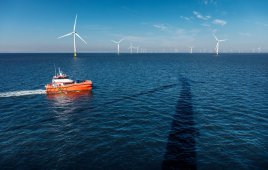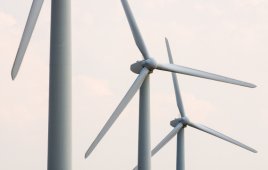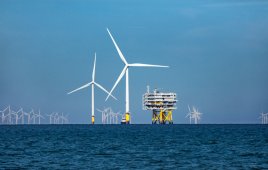Blades are the leading edge of a wind turbine so their aerodynamic surfaces carry critical shapes in a fluid (air) that seems bent on removing the shape. Blade tips often hit 180 mph, so it’s no surprise that sand, rain, and hail wear and damage their surfaces.
Trends in blade maintenance show up in two distinct areas: damage detection and repair.
“To gain initial baseline blade damage insight, we first suggest an on-ground visual examination of 10 to 20% of a site’s blades by using a scope and high-resolution camera in order to achieve a statistical handle on possible blade problems,” says Rope Partner Director of R&D and Business Development Chris Bley. “Depending on our findings we use rope access techniques to inspect the blades more closely. After gathering this baseline information, it’s possible to calculate trending, an indicator of how the blades are performing for particular locations.” One trend now is to conduct such inspections before turbines come out of warranty.
“More cautious owners/operators choose not to take a statistical approach before the expiration of warranty, they feel inspecting 100% of their blades from the ground and 10 to 20% on ropes is necessary to protect their valuable assets.” says Bley.
Should a closer inspection become necessary, technicians can use sonic devices to evaluate the damage. Ultrasonic units have been useful in these tasks but they require applying a water or gel (a couplant) to the blade surface and examining small areas – a few inches square – at a time. Recently, a more promising method uses light for a more in-depth diagnosis, over a larger area without contacting the blade.
The optical inspection method, shearography, has had widespread use in the aerospace and marine industries. “It’s laser based technique that lets us measure small surface deformation that are indicative of subsurface defects says Dantec Dynamics’ Matt Crompton. “The defects could result from manufacturing, weather, or fatigue. The unit works fast taking roughly 30 sec to sample an area about 1 ft2, and it’s highly repeatable. The device works well on glass or carbon-fiber constructions.”
The equipment works by subjecting a composite surface to a small stress, usually either a slight temperature rise of 1 or 2 degrees, or a small pressure change and then the laser light can measure sub-micron surface movements. The unit quickly detects flaws below the surface including wrinkling, delamination, and impact damage. There is no surface preparation required, and 150 ft2 can be scanned in an hour. It’s used in field and up tower for instant results,” he says. A structural engineer with knowledge of the blade’s construction and loading will have to decide how to treat the problem. The identified flaw could lead to cracking and ultimately blade failure.
Additional trends include using the data to predict which other blades from a lot might have a particular flaw. The idea being that early detection allows better and less costly repairs.
Because the best defense is a good offence, Rope Partner’s Bley suggests preventing blade wear by placing a durable polyurethane tape over its leading edge. 3M developed the clear rugged tape–difficult to pierce with a scissor point–for the leading edge of helicopter rotors. The material company is also wrapping up a study on how blade erosion negatively affects aerodynamics that cause turbulence which may reduce the overall turbine output. 3M will release the study at AWEA’s Windpower 2011. “Over the last decade, we’ve seen damage at sites across the globe due to leading-edge erosion when conducting inspections for wind turbine maintenance and repairs,” adds Bley. “At some sites, significant erosion occurred in a little as two years after installation.”
WPE
Filed Under: O&M



